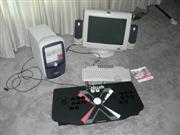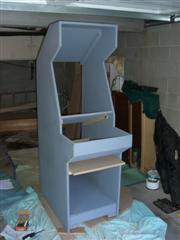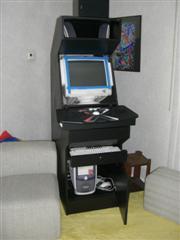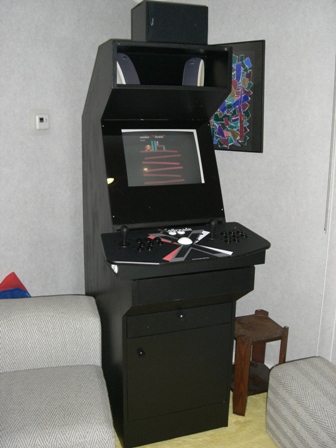My Amazing Machine Experience
 Growing up in the 80’s I was like most other semi-nerdly teens. I was a sucker for arcade machines. One of the best deals of my middle school life was when the local arcade gave out tokens for grades on our report cards. (As a pretty smart little nerd, I was taking something like 10 classes and getting A’s in all of them – at 4 tokens for an A that’s a nice pile of change.) I came into a bit of “fun money” last spring, adding in my birthday presents I decided the time had come, I was going to build myself my very own arcade machine.
Growing up in the 80’s I was like most other semi-nerdly teens. I was a sucker for arcade machines. One of the best deals of my middle school life was when the local arcade gave out tokens for grades on our report cards. (As a pretty smart little nerd, I was taking something like 10 classes and getting A’s in all of them – at 4 tokens for an A that’s a nice pile of change.) I came into a bit of “fun money” last spring, adding in my birthday presents I decided the time had come, I was going to build myself my very own arcade machine.
I had thought about doing this for many years, but several things stopped me. First, the cost. I’ve seen arcade games for sale on the floor of various game conventions, but they all start at $1500 or so and go up from there. Depending on the game, even old (working) arcade games run in the hundreds of dollars. There had to be a less expensive way. Enter MAME. MAME (Multiple Arcade Machine Emulator) is a project by some driven programmers who love arcade games and want to try to recreate in software all the bits and parts that were in old arcade machine hardware. Basically, arcade machines had most of their programs on computer chips (ROMs) that would plug into the arcade hardware board. Swap out the ROM chips for another set and you could play a new game with the same arcade machine (since the machines were pretty expensive and games tended to go out of style rather quickly.) With the power of present day computers, it is easy for them to emulate (in software) all the hardware of 80’s and early 90’s arcade games. The MAME programmers are simply trying to recreate those older arcade games as accurately as possible (going so far as to giving options to “overlay” scanlines over the computer screen to make the graphics closer to old school monitors and refusing to put in any save-game features that save high scores when the machine is off – because the original arcade games didn’t save high scores when they were turned off either).
I had been aware of MAME for some time, but there was one big hurdle I first had to overcome. The MAME program itself is freely distributed, but it doesn’t come with any ROM files. That is because the ROMs are essentially software programs and copying old ROMs is a form of copyright infringement. This was a major stumbling block for me, as I try to keep my music, movies, and games all on the right side of the law. As a teacher and a youth volunteer I figure I need to be setting the right example for the young-uns I hang out with. After scouring the net trying to find a way to legally purchase ROMs I had a revelation. I already own several copies of most of my favorite games. I have arcade game compilations for my PC (Microsoft Arcade, Atari Classics 1&2), on my Gameboy (Namco Collections, Ms PacMan, Super PacMan), and on my game consoles (Midway Arcade Treasures, etc…) Somewhere in each of those collections is a copy of the original game’s ROM chip. I realize it is a bit of a grey area (and I respect opinions on both sides of this issue) but I figured it was as close to owning the ROMs for those games as I was going to get. (I would have bought the ROMs in a totally legal way if I could have found a source for them.) Those who are really sticklers about the issue can still build their own arcade machines, they will just have to own all their arcade games on the machine they choose to put inside the console. (Several commercial arcade sites do this, putting a PS2 with several different arcade collections inside of an upright arcade cabinet.)
I had a mission, and a budget – it was time to get to work. Actually, I thought I’d wait until my dad came in to town as he has more tools and more woodworking experience than I do. I found some plans on the internet and made a shopping list. When my folks came to visit, dad and I took a trip to the hardware store (and another trip, and another, etc… mostly to upgrade tools I didn’t forget much in the way of parts). Then came home and started cutting. The plans I had gave a general shape of an arcade machine, we simply cut it out of 3/4 inch medium density fiberboard (MDF) and braced it together with some 2x2s and a few 2x4s to make a solid base. To spruce up the basic pattern, I added in a drawer in the front for the computer keyboard, and a swinging door for the bottom front for easy access to the computer power switch and disc drives. I bought an old Compaq computer (circa 2000) for $80 off of Craig’s List that included speakers and a 19” monitor. I had been leaning towards a slightly larger LCD screen due to weight and size constraints, but this was a great deal for the price.

Dad and I spent one solid afternoon shopping, about an afternoon and a half assembling, and then another day or two painting. (Actually I finished the painting after he left.) I even scored some clear plastic my neighbors were throwing out and painted it to hide the outside of my monitor to give the cabinet a more contained look. All in all, I’m very pleased by the thing. I figure the whole thing ran me about $500 or so. $200 for the double-joystick with trackball controls (X-Arcade Tankstick from www.x-arcade.com), $80 for the used computer, speakers, and monitor. And roughly $200 for all the wood, screws, rollers, knobs, etc… As with many woodworking projects I did probably spend another $100 to $200 on new tools that I just “had” to have.


The biggest time sink in the whole project has actually been fiddling with the software side of things. MAME is a command line program (think DOS or something similar) and so scrappy programmers have also made a fancy Windows version called MAME32 (now called MAMEUI as there is a 32 bit version and a 64 bit version). Unfortunately, the newest versions of MAME and MAMEUI (version .125) don’t really like my archaic 2000AD video card. I was using an older version of MAME32 (version .66) which worked, but didn’t have all the nicer features of some of the newer versions. After a week or two of fiddling with this and that, and much asking around, I found an archive of MAME32 executables. By trial and error I found a newer version (v0.106) that had features I liked and still ran on my older machine.

Looking towards the future, I have permission for the arcade cabinet to stay up in our family room for the summer. However, I’ve convinced my wife to help me decorate it. I figure if I can get her to paint it in patterns and colors she likes, I just might be able to keep it up in our family room on a long term basis. In the meantime, someone could come to my rescue and tell me how I might go about buying a legal copy of the ROM for Bump ‘n Jump (also known as Burnin’ Rubber)? It’s one game I remember very fondly from the 80’s of which I don’t have a legal (even a semi-legal) copy.
I’ve written enough for now, time for me to get back to an intense game of Tempest (a trackball makes a great substitute for the little dial thingy).





June 28th, 2008 at 3:06 pm
Awesome! I want one now.
Im talking about a wife who would let me keep an arcade cavinet upstairs.
June 28th, 2008 at 7:09 pm
If you really, really want to be a stickler about “legal” ROMs, you can scour ebay for people selling the original arcade boards. Depending on the game, you can find some of them dirt cheap — usually from some wholesaler who’s salvaging parts from a machine that got beaten to death by wear and tear. You’d be pretty hard pressed to sue a guy for emulating a game that he has the hardware for.
June 28th, 2008 at 11:54 pm
Very cool story Matt! Love the pic with the youngster helping out. I’ve got one of Henry hanging uselessly on a wheel barrow I’m pushing.
July 1st, 2008 at 1:28 pm
Depending on whether you’re a half full or half empty guy, it’s getting easier to ethically justify downloading ROMs. Having a couple of Sonic the Hedgehog cartridges floating around the house as well as buying it on the Wii VC, I’d have no qualms about downloading a copy to play on a PC. As Matt points out, the growing market for “retro classics” means that a lot of the best games are being re-released in full emulated form, or there are even prebuilt arcade emulation cabinets that ship with licensed games. Buying any of these would let me download ROMs for use with my own emulator setup without losing any sleep.
I don’t feel I’m impacting a company’s bottom line if I’ve already bought an old game in one form _or_ they offer no way to purchase otherwise. Legally it’s a different issue, but come on, you’ve never jaywalked? 😉
July 2nd, 2008 at 10:22 am
btw Matt.. http://www.quarterarcade.com/Game.aspx/385
September 4th, 2008 at 4:43 am
hey really love your arcade setup….can I get one too …Im just too dum to make one on my own !
http://www.electrocomputerwarehouse.com/
April 16th, 2009 at 4:03 am
I think the games of olden days were more relaxing while today’s game are more action oriented and makes people like me go haywire.
October 12th, 2009 at 11:12 pm
Creative minds surely bring out creative products and this is the reasion behind their success.
http://www.resumehype.com
December 8th, 2009 at 12:50 am
Creative work.
http://www.bestsampleresume.com
April 25th, 2019 at 10:51 am
Absolutely right! There’s no such word as “too prepared” nowadays. I also decided to update my resume after I found a similar article on this site https://federalresumeguide.com/articles/ Therefore, I completely agreed with the article and recommend it to everyone to update your resume right now.